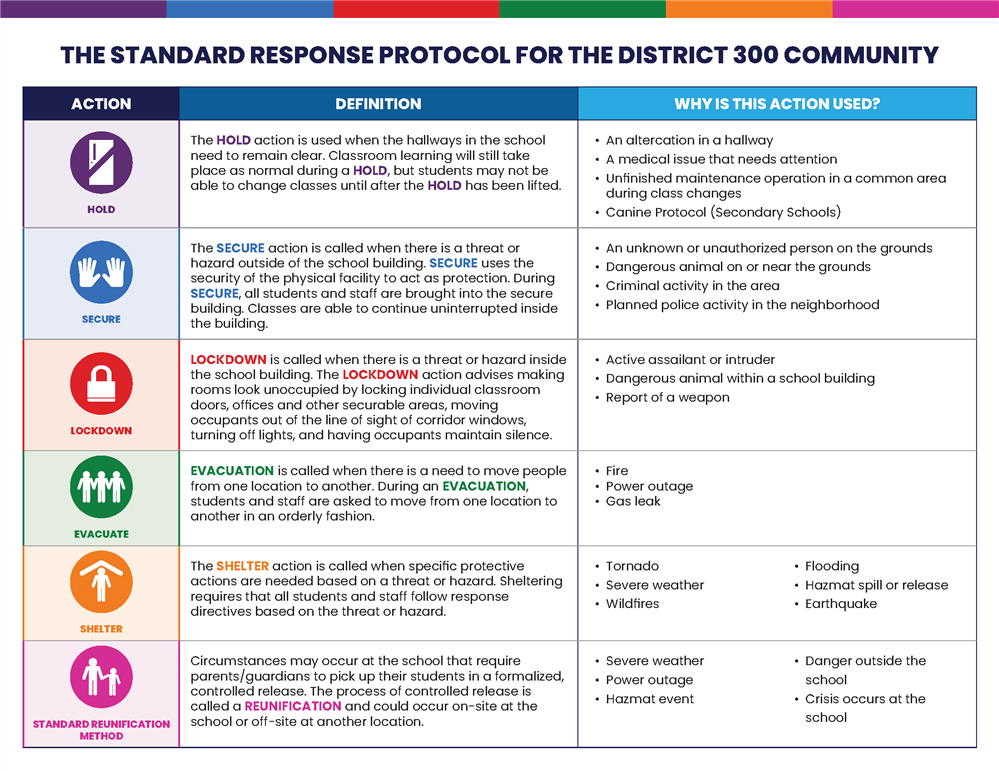School Safety
-
In these uncertain times, an emergency or disaster can strike any school community at any time. It is the responsibility of schools to care for and protect what is, arguably, this country’s most valuable resource: children. Safety and a sense of security are key elements of a positive learning environment. Without such security, schools cannot function effectively especially if teachers cannot teach and students cannot learn when they are – or feel that they are – continuously under threat. Safety, therefore, should be the first responsibility of administrators, teachers, counselors, supporting staff members and persons at every level...both within our schools and our communities.
Whether a school-related emergency takes the form of natural disasters, such as fires, tornadoes or earthquakes, or man-made disasters, such as school shootings, active violence or acts of terrorism, the school system should be prepared to respond to these types of events and to work in partnership with local public safety officials to address the needs of the affected students and staff quickly...and to return the school community to a state of normalcy.
Bullying Prevention
District 300 believes that the primary function of its schools is to help students reach their potential as self-directed learners and responsible citizens. A safe and orderly school environment is crucial to this process.
Bullying disrupts a schools safe and orderly environment. Bullying creates a climate of fear and hostility, disrupts the educational environment, inhibits the ability to learn, adversely affects student participation in educational programs and activities, creates a negative effect on the schools social environment and leads to antisocial behavior.
District 300 expects students to act with consideration and respect for other students, staff and their property. School personnel are responsible for creating a safe, orderly and respectful learning environment where students can gain the knowledge and interpersonal skills they need to succeed.
District 300 prohibits any and all forms of bullying by students and will not tolerate acts of retaliation for standing up against or making a report of bullying. School staff shall investigate, identify and stop bullying behavior with appropriate discipline and interventions.
District 300 has researched many Bullying Prevention Strategies. Click the resources located in the menu on the side of the page for a list of resources that were used to help design our procedures
-

Director of School Safety
and SecurityDr. Joe Przybyla
joseph.przybyla@d300.org
-
District 300 School Safety Plan and Parent Resources
District 300 takes the safety of our students, staff, and visitors extremely seriously. While there is no plan that can totally prevent a random act of senseless violence like this, our district has a school safety plan in place that has been developed in close partnership with law enforcement authorities and regularly practiced by our faculty and staff. The following are some features of our school safety plan:
- District 300 employs a full-time Director of School Safety and Security, Dr. Joe Przybyla. Dr. Joe Przybyla, who has over two decades of law enforcement experience working for Northeastern and Northern Illinois universities. Dr. Przybyla is also a state certified paramedic. In Illinois, very few districts have a full-time security expert on staff.
- The district works closely with the numerous police, fire, and sheriff's departments throughout the district's 15 municipalities. These first responders have all been provided copies of our school floor plans and have been trained on District 300's internal processes, so that they know exactly where to go and what to expect within our schools in the case of an active shooter or other dangerous situation.
- Each year, everyone who works with our students receives training on how to handle the potential for a violent situation. This includes regular and substitute teachers, office and support staff, bus drivers, administrators, and others.
- Each year, District 300 students and staff review and practice lockdown procedures.
- District 300 schools are all equipped with video surveillance.
- District 300 schools all require visitors to be buzzed-in for entry.
- Police liaison officers from the local police departments work in all of our middle schools and high schools.
- A safety hotline is available that allows students and adults to provide anonymous tips, 24 hours a day, about weapons, violence, bullying, and drugs. The hotline number is 847.551.8477. Tips can also be sent via email to SafeSchoolTipLine@d300.org.
Important Information Regarding District 300 Safety Procedures:
The decision to activate our safety procedures is based upon multiple factors including recommendations by local law enforcement, proximity of an event to our schools, and the severity of the event. Based on this information, we determine the schools and facilities that are directly impacted. When activated, the District will initiate the communication protocol to keep those directly affected by an emergency informed. To ensure a comprehensive communication process, the District uses a combination of our Rapid Communication System (RCS), district website, and social media to relay information.
The RCS system consists of phone messaging and email. In an emergency, the RCS system will only utilize email functions. Phone calls will not be part of the initial communication protocol. Instead, regular updates will be provided via the email function of the RCS tool. This allows phone lines to remain open for staff to maintain communication with our administrators and various law enforcement and emergency agencies. The use of social media (Facebook) will also be utilized to post the same messages conveyed through the RCS system. This ensures consistency of what is being communicated and that we are capturing the greatest possible audience. Once detailed information is available, the phone messaging system will be activated.
Standard Response Protocol
District 300 has adopted the Standard Response Protocol (SRP) from the "I Love You Guys" Foundation. The SRP provides a shared vocabulary and clear set of actions that guide schools in responding to a range of safety-related incidents. Used by more than 50,000 schools, agencies, and organizations around the world, the SRP includes five key actions: Hold, Secure, Lockdown, Evacuate, and Shelter. These actions are designed to address a wide variety of situations, from medical events and weather emergencies to hallway disruptions and intruders.
District 300 has also adopted the Standard Reunification Method to ensure a safe and orderly process for reuniting students with their families in the event of an emergency. This sixth action, Reunification, works in tandem with the SRP to provide a comprehensive approach to safety and crisis response.
Each year, schools are required to conduct various drills, including fire drills, severe weather drills, and lockdown drills. You can expect to receive communication from your child’s school in advance of any scheduled drill. Additionally, if we ever need to implement one of these actions in response to an actual safety event, you will be notified.
The safety and well-being of every student and staff member remain our highest priority. We encourage all families to review the Standard Response Protocol and reunification information below so we can all work together to ensure a safe, informed, and prepared school community.
- District 300 employs a full-time Director of School Safety and Security, Dr. Joe Przybyla. Dr. Joe Przybyla, who has over two decades of law enforcement experience working for Northeastern and Northern Illinois universities. Dr. Przybyla is also a state certified paramedic. In Illinois, very few districts have a full-time security expert on staff.

-
If you are having trouble viewing the document, you may download the document.

HOLD
Definition: The HOLD action is used when the hallways in the school need to remain clear. Classroom learning will still take place as normal during a HOLD, but students may not be able to change classes until after the HOLD has been lifted.
Why this action is used:
- An altercation in a hallway
- A medical issue that needs attention
- Unfinished maintenance operation in a common area during class changes
- Canine Protocol (Secondary Schools)

SECURE
Definition: The SECURE action is called when there is a threat or hazard outside of the school building. SECURE uses the security of the physical facility to act as protection. During SECURE, all students and staff are brought into the secure building. Classes are able to continue uninterrupted inside the building.
Why this action is used:
- An unknown or unauthorized person on the grounds
- Dangerous animal on or near the grounds
- Criminal activity in the area
- Planned police activity in the neighborhood

LOCKDOWN
Definition: LOCKDOWN is called when there is a threat or hazard inside the school building. The LOCKDOWN action advises making rooms look unoccupied by locking individual classroom doors, offices and other securable areas, moving occupants out of the line of sight of corridor windows, turning off lights, and having occupants maintain silence.
Why this action is used:
- Active assailant or intruder
- Dangerous animal within a school building
- Report of a weapon

EVACUATE
Definition: EVACUATION is called when there is a need to move people from one location to another. During an EVACUATION, students and staff are asked to move from one location to another in an orderly fashion.
Why this action is used:
- Fire
- Power outage
- Gas leak

SHELTER
Definition: The SHELTER action is called when specific protective actions are needed based on a threat or hazard. Sheltering requires that all students and staff follow response directives based on the threat or hazard.
Why this action is used:
- Tornado
- Severe weather
- Wildfires
- Flooding
- Hazmat spill or release
- Earthquake

REUNIFICATION
Definition: Circumstances may occur at the school that require parents/guardians to pick up their students in a formalized, controlled release. The process of controlled release is called a REUNIFICATION and could occur on-site at the school or off-site at another location.
Why this action is used:
- Severe weather
- Power outage
- Hazmat event
- Danger outside the school
- Crisis occurs at the school
Missing Student Protocol
If your child is a bus rider and doesn’t return home:
First contact your child’s school to ask if your child is participating in an after school activity or to confirm that your child boarded the bus.
Your school will contact the transportation department and alert the district safety officer 847-652-1643.
If you can’t reach anyone at your child’s school, call the transportation depot. The depot is staffed until 6:00 p.m., Monday thru Friday (when school is in session).
- For routes beginning with the number 1 call 847-426-1975, these routes are dispatched out of the Carpentersville depot located directly behind Oak Ridge School at 300 Cleveland Avenue.
- For routes beginning with the number 2 call 847-658-3262, these routes are dispatched out of the Algonquin depot located at 2603 Bunker Hill Drive between the Administration Center and Jacobs High School.
Dispatch will immediately notify your child’s bus driver for information. Dispatch will alert all drivers to be on alert for an extra student or missing child.
Contact the local police department, then contact your child’s friends.
Visitor Management System
1. What is the RAPTOR Electronic Visitor Management system?
RAPTOR is a visitor registration system that is in place in all Community School District 300 schools. Visitors will be required to bring one of the following; a U.S. state license, U.S. state identification card, concealed handgun licenses, consular ID cards, Alien Registration Receipt Card (green cards), active military cards, and a passport card (not the full passport) when visiting a Community Unit School District 300 for any period of time.
2. How does it work?
The ID will be scanned to check visitors against a sex-offender database prior to granting them access to the learning environment of the school building.
3. Why is Community School Unit District 300 using this system?
The purpose of this initiative is to expedite and enhance existing security procedures for the safety of students and staff. The new electronic system implemented is used in many surrounding school districts and replaced the sign-in system.
4. What information is taken from the form of identification?
Raptor is only scanning the visitor’s name, date of birth, partial license number, and photo for comparison with a national database of registered sex offenders. Additional visitor data will not be gathered and no data will be shared with any outside company or organization
All visitors and volunteers granted access into the school building during the day while students are present must have their form of identification scanned and wear the Raptor badge. Once scanned, the information will be stored so parents will not be required to present identification on future visits.
The process pertains only to granting visitors access into the school beyond the main office during the school day while students are present. It does not apply to parents who are simply dropping off a forgotten item or who are picking up their student from school.
5. Do we require parents to produce identification before entering the school for special events such as open house, parent/teacher conference, plays, festivals, etc.?
These procedures do not apply to school activities OUTSIDE of the normal school day. These procedures do apply ANY TIME a visitor will be granted access into the school during the day while students are present regardless of the nature of the visit.

